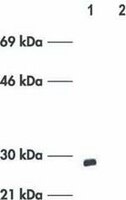PC67 Sigma-AldrichAnti-Bcl-xL (Ab-1) (201-216) Rabbit pAb
Productos recomendados
Descripción
| Replacement Information |
|---|
Tabla espec. clave
| Species Reactivity | Host | Antibody Type |
|---|---|---|
| H, M, Op, R | Rb | Polyclonal Antibody |
| Product Information | |
|---|---|
| Form | Liquid |
| Formulation | In 50 mM sodium phosphate buffer, 0.2% gelatin, pH 7.5. |
| Negative control | Brain tissue |
| Positive control | Doxorybicin-treated MCF-7 cells (see comments) or intestinal tissue |
| Preservative | ≤0.1% sodium azide |
| Quality Level | MQ100 |
| Physicochemical Information |
|---|
| Dimensions |
|---|
| Materials Information |
|---|
| Toxicological Information |
|---|
| Safety Information according to GHS |
|---|
| Safety Information |
|---|
| Product Usage Statements |
|---|
| Storage and Shipping Information | |
|---|---|
| Ship Code | Blue Ice Only |
| Toxicity | Standard Handling |
| Storage | +2°C to +8°C |
| Do not freeze | Yes |
| Packaging Information |
|---|
| Transport Information |
|---|
| Supplemental Information |
|---|
| Specifications |
|---|
| Global Trade Item Number | |
|---|---|
| Número de referencia | GTIN |
| PC67 | 0 |
Documentation
Anti-Bcl-xL (Ab-1) (201-216) Rabbit pAb Ficha datos de seguridad (MSDS)
| Título |
|---|
Anti-Bcl-xL (Ab-1) (201-216) Rabbit pAb Certificados de análisis
| Cargo | Número de lote |
|---|---|
| PC67 |
Referencias bibliográficas
| Visión general referencias |
|---|
| Datta R., et al. 1995. Cell Growth Differ 6, 363. Fang W., et al. 1995. J. Immunol. 155, 66. Gonzalez-Garcia M., et al. 1994. Development 120, 3033. Krajewski S., et al. 1994. Cancer Res 54, 5501. Boise L.H., et al. 1993. Cell 74, 597. |
Folleto
| Cargo |
|---|
| Caspases and other Apoptosis Related Tools Brochure |













